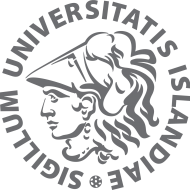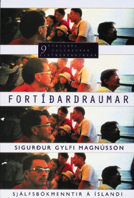Dreams of Things Past: Life Writing in Iceland. Anthology from Icelandic Popular Culture 9. Published by the Icelandic University Press, 2004. 427 pages. – (Fortíðardraumar. Sjálfsbókmenntir á Íslandi. Gestaritstjóri Guðmundur Hálfdanarson. Sýnisbók íslenskrar alþýðumenningar 9 (Reykjavík: Háskólaútgáfan, 2004)).
Iceland has a long tradition of biographical writing. Over the centuries Icelanders have been telling stories about unusual and noteworthy people and the things they had been through and set many of them down in written form. The sagas of Icelanders – the “Icelandic family sagas” as they are known – provided the actual models for accounts of this kind, most of which dealt with ordinary people going about their day-to-day lives. When the modern autobiography took shape in the early years of the twentieth century it owed a great deal to these antecedents, which set their mark on its form and techniques. In addition it received the legacy of the modern development of the self as it had taken shape in Western culture since the time of the Enlightenment. The outcome was frequently an interesting mixture of the European literary heritage and the native Icelandic narrative tradition.
The present work, Dreams of Things Past: Life Writing in Iceland, discusses this world of twentieth-century “life writing” or egodocuments (sometimes called auto-literature) and how it changed and developed during the course of the century. The first part of the book sets out the different ways in which the self manifests itself in autobiographical writings (where author and main character are the same person), memoirs (where the main character is someone other than the author), in colloquies and conversational books (in which an interviewee answers particular and specific questions on the part of an interviewer), auto-fictions (in which the declared intention of the author is the free treatment of facts chiefly from his or her own life), and finally biographies (where the main character is dead and the author working on his life is some individual unknown or irrelevant to him). This section attempts to show, with illustrative examples, the characteristics of the different types of works within each class and so to draw up definitions designed to be of use in scholarly work on the sources. As is made clear in the conclusion to the chapter, there is considerable overlap between the categories and it is often difficult to specify unequivocal features that distinguish one group from another. On the other hand, in all cases it is of central importance to identify the position of the author with regard to the text and assess the level of his or her independence in the work.
Autobiographical writings have remained extremely popular in Iceland throughout the twentieth century and beyond. Large numbers of individuals have presented themselves in print, keen to tell the story of their times and experiences and confirm their part in the building of Icelandic society. All these writings have a powerful nationalistic undertone, in affirmation of the view that each and every individual has their part to play and their contribution to make. Most of the authors were farmers from various levels of society and a recurrent motif is that of shouldering personal responsibility – increasing the size of their hay meadows, tilling the soil, building up their farms – all to the greater glory of the nation.
Shortly before the middle of the twentieth century life writing or egodocuments underwent a process of “mechanization” through the emergence of a particular group of writers specializing in presenting ordinary people’s testimony of national life. These efforts appeared in the form of memoirs and conversational books in which special emphasis was laid on demonstrating the entrepreneurial spirit of the Icelanders and how each one of them had contributed something to advancing the country’s interests. These types of life writing involved a significant change in the status of the main character: the ostensible subject was no longer the active party, the “doer”, but a passive participant in a work controlled by an author. There was thus a considerable difference between these kinds of writings and autobiographies, even though in most cases they were produced with close cooperation between the author and main character. In this way there was significant change in the field of life writing: autobiography remained as popular as ever, but new genres appeared on the scene that gave more people the chance to express their ideas and recount the course of their lives. Many who would have been daunted at the prospect of producing works of this kind found things a great deal easier with the hand of a professional expert to guide them on their way.
Of all the genres of egodocuments in twentieth-century Iceland, auto-fiction was the last to emerge. Initially, most of these works were produced by authors who had been active for much of the century. Established writers used their own selves as material in their books and to start off with the literary world found it difficult to orient itself to precisely what kinds of works these were. Were they, for instance, pure fiction, or some type of reminiscences with a novelistic thread running through them? In the last two decades of the century a change occurred whereby many authors started to approach their own selves and their histories in a much more conscious and systematic manner than had previously been the case to create an entirely new literary genre. They defined themselves and their works squarely within the confines of auto-fiction. In recent years ever more writers have chosen deliberately to exploit the loose connections between reality and the course of their lives that has always been the distinguishing mark of auto-fiction. This has come about, of course, as a consequence of the breakdown of the grand narratives in which the conventional frames of references that had directed people on their way through their daily lives were found no longer to hold good. For this reason many people other than professional writers turned to auto-fiction as a means of shaping their own identities in the public arena. Moreover, the deconstruction of received values led to a loosening not only of the constraints on the forms of writing here designated “life writing” but also on the ideas held by historians about the past. As a result, these sources suddenly became more interesting tools for scholars wishing to examine the world.
The second chapter turns to certain other first-hand sources in which individuals make an attempt to shape and create their own selves. These sources are very varied and fulfil a number of different roles in people’s cultural lives. The group includes diaries, correspondence, questionnaires, learning and lore on national matters, interviews (oral history), obituaries, epitaphs and even certain types of public documentation. Within these sources the individual comes out with uneven strength and clarity, attempting to shape and present his own persona, i.e. to create an individual. The most striking feature of this group of egodocuments is that in later years they have become an ever more significant arena for the release and expression of emotions by people who, it appears, have felt a powerful need to make various experiments with the self, to hop between different personas and try themselves out and assess themselves in different roles. The “blog” is the clearest example of this change, though in fact various other types of web-based media have enabled people to shift relatively easily between actuality and virtual reality.
The overall conclusion of these first two main chapters of the book is that man is not single but multiple. It is not possible to speak of any individual as being one and the same person from the cradle to the grave. The natural decline that brings people eventually to death is not the primary factor here, but rather changes in people’s spiritual and mental faculties and attainments throughout the entire course of their lives. The works we list under the heading of life writing, egodocuments, or auto-literature demonstrate unambiguously that every person undergoes major and deep-seated changes from one period to another. This characteristic of the human condition is not always equally apparent in the works but is seen most clearly in later times, when self-expression becomes commoner; it simply occurs more often in the course of life itself. In some cases what we find is continuous and integrated expression, as in the case of diaries or blogs. If this view is correct, it then seems proper to ask what effect this has on our ideas about the past, about history, the sources, and the person in question? This question and its implications provide one of the main themes of the next two chapters of the book.
The third main chapter considers the ways in which modern scholarship has used people’s personal testimony of their own selves. Put in briefest terms, it is fair to say that for most of the twentieth century scholars had only limited interest in these sources. There have however been periods in which scholarly attempts to work systematically with popular testimony of past times have enjoyed considerable favor and support, for example the “life history approach” associated with the Chicago school. Social history and all the scholarly experimentation associated with it have, however, tended to concentrate on the structural forms of society at the expense of the individual as a historical phenomenon. Thus the main subjects for research have been the groups and classes that underlie society, with little attention being paid to particular individuals, their emotions and needs. For these reasons social historians have often turned by choice to quantitative methods in their research and have tended to steer away from first-hand sources and the qualitative approach they have to offer. The main thrust of sociohistorical research continued along these lines until late into the 1980s. With the rise of the methods of microhistory this development changed a great deal. The individual became an important subject matter for scholarly research towards the end of the twentieth century.
In the final section of the book, the methods of microhistory are applied in presenting an illustrative example of how those who possess power use this power without compunction to suppress and silence undesirable debate, in this case in connection with a controversial biography that came out in Iceland late in the year 2003. The book’s author, a well-known friend of the powerful, was found to be guilty of wide-scale plagiarism in his work. Instead of the author’s acknowledging his mistake and withdrawing the book from sale, as many authors in Western countries who found themselves in similar circumstances have done, a coordinated campaign of slander and innuendo was launched against those who had had the temerity to criticize the author. The full details of the debate, which stretched over more than a month and a half, are gone over and analyzed, showing how many of the most powerful people in the country rallied behind the author and attempted to defend a work that had patently been produced in a way that fell well short of scholarly standards. The whole case is instructive for the complex status enjoyed in the modern world by the kinds of literature we classify as life writing or egodocuments and the influence that works of this kind can exert. In addition, it is highly revealing on the methods used by those who exercise power to control and direct the discourse and how they react to any attempt to expose their methods and their power.

